Windows 10 upgrade benefits for customers with subscriptions in CSP
Executive summary
This document explains how businesses can upgrade PCs and devices still running Windows 7 or Windows 8/8.1 to Windows 10 at no additional cost via upgrade benefits included with Windows subscriptions (including Microsoft 365 offerings) in the Cloud Solution Provider (CSP) program.
Introduction
Organizations with active subscriptions in the Cloud Solution Provider (CSP) program, that include Windows, can now upgrade their Windows 7 and Windows 8/8.1 PCs and devices to Windows 10. This is an important added benefit as it enables companies still on Windows 7 Pro or Windows 8/8.1 Pro to move to the most secure Windows ever without the need to purchase additional device upgrade licenses.
To learn more about Windows 10 subscriptions through the CSP program, see the related document called Introduction to Windows 10 subscriptions in the Cloud Solution Provider program .
Why choose Windows 10
Windows 10 is the most secure release of Windows ever, with intelligent security capabilities designed to work together to better protect customers' organizations.
By using the power of the cloud, Windows 10 helps simplify the complexity of managing today's modern IT device environment, no matter the size of the organization. In addition, Windows 10 facilitates the creativity, teamwork, and productivity both users and IT love. Major benefits of upgrading to Windows 10 include:
- Intelligent security. Windows 10 is unique in providing a set of advanced, integrated security capabilities designed for the modern and sophisticated threats that organizations face today. With Windows, for the first time, you get one solution for both Endpoint Protection (EPP) and Endpoint Detection and Response (EDR). Next generation, real-time threat intelligence and integration with the Microsoft Secure security stack (Office 365 Advanced Threat Protection, and Microsoft Advanced Threat Analytics) provide a solution that helps protect devices, messaging, and identities. Windows 10 advanced security features are designed to work together to help improve the user experience for IT and end users, as well as reduce costs and complexity, and save time.
- Integrated for simplicity. Windows 10 and the cloud are transforming the IT landscape by modernizing your IT management processes from device procurement to support. Windows 10 reduces complexity by enabling IT to harness the power of the cloud to deploy, manage, and update devices in the office or anywhere employees need to work using serverless device management. New devices don't require imaging by IT to meet corporate standards. Windows Analytics provides quick insights into the health and efficiency of your environment to ensure employees are compliant and have the best possible user experience, including smooth upgrades.
- Enables creativity and teamwork. Windows 10 enables creativity to boost employee productivity and teamwork. Together with Office 365, Windows 10 equips users with the broadest and most comprehensive set of apps and services, giving teams the tools they need to produce their best work, along with flexibility and options for how they connect, share, and communicate. Core platform capabilities and features that sync across different devices help employees get their digital workspaces organized, stay on track, work faster, and get more done.
Why upgrade from Windows 7 to Windows 10
Many organizations still use Windows 7 in their computing environment. It is time to move from Window 7 to Windows 10, and there are many compelling reasons to do so, including:
- Windows 7 is almost 10 years old. A lot has changed in 10 years…. Windows 10 is faster, improves device battery life, and supports modern input and interactivity methods. With Windows as a Service, Windows 10 is always up to date with intelligent security features in response to the latest security threats. Windows 7 was the right choice in 2009. Today the right choice is Windows 10.
- Windows 7 can't get you fully to the cloud. Windows 10 can. The future of identity and cloud-based device management is Azure Active Directory (Azure AD) and Microsoft Intune. With Windows 10, the future is here now. Devices still on Windows 7 rely on legacy on-premises infrastructure. Only Windows 10 supports both legacy and modern device management, giving you the best of both worlds while supporting your transition to the cloud.
- You might not know it, but you're (probably) ready According to Microsoft research, over 99 percent of Windows 7 apps work with Windows 10. And with in-place upgrades, moving to Windows 10 can take less than an hour with options to keep apps, files, and settings—–or to start again with a clean slate.
When you upgrade now, you get ahead of the January 2020 end-of-support deadline.
Overview of upgrade benefits based on version
To deploy a Windows subscription licensed through the CSP program, end user devices must be running Windows 10 Pro version 1607 (Anniversary Update) or later. To accommodate upgrades, most Windows and Microsoft 365 subscriptions in the CSP program include upgrade benefits for devices running Windows 7, Windows 8, and Windows 8.1.
These upgrade benefits work as follows:
- Upgrades maintain the same Windows edition.
- This means devices running Windows 7 Pro, Windows 8 Pro, or Windows 8.1 Pro upgrade to Windows 10 Pro.
- Organizations that purchased consumer laptops may be running consumer editions of Windows, such as Home or Core edition. Customers can upgrade to Windows 10, but will remain on the consumer edition. The upgrade process does not change the edition from Home or Core to Pro. This distinction is important because customers with devices running consumer editions of Windows must upgrade from Windows 10 Home to Windows 10 Pro to deploy a Windows subscription on their device.
- Upgrade benefits to Windows 10 are granted to users with active subscriptions. If a user within an organization wants to upgrade their devices to Windows 10 from Windows 7, Windows 8, or Windows 8.1, they must have an active subscription attached to their user account at the time of upgrade. Users without active subscriptions cannot upgrade devices through CSP.
- Upgrade benefits are not granted to the entire organization by default, only to users with active subscriptions, unless the organization has licensed all users.
- A user can upgrade as many devices as they want if they have an active subscription.
- Upgraded Windows 10 device licenses are perpetual and not revoked when subscription ends. So, when a user's subscription ends, is cancelled, or reassigned to another user, the upgraded devices remain active on Windows 10 and continue to receive security patches and feature updates.
- No product keys are issued with a Windows 10 upgrade. Windows 10 uses digital entitlement, which is associated with the device and persists even when Windows is reinstalled.
Upgrade eligibility
Not all versions and editions of Windows can upgrade to Windows 10, and not all subscriptions in CSP include Windows 10 upgrade benefits. The following image offers an overview of paths.
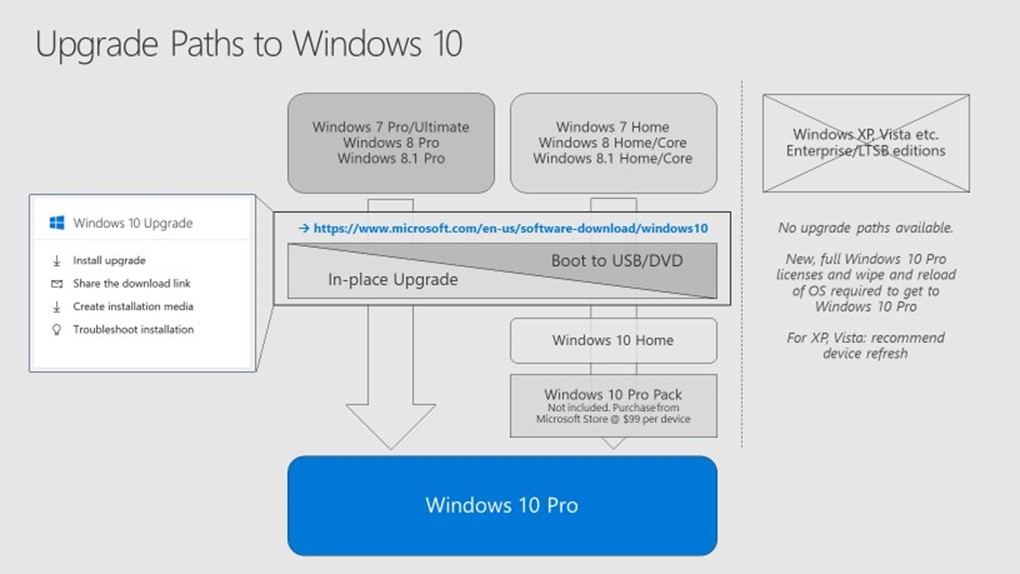
The following subscriptions include upgrade benefits to Windows 10:
- Windows 10 Enterprise E3 (local only), Windows 10 Enterprise E3, Windows 10 Enterprise E3 with VDA
- Windows 10 Enterprise E5,
- Microsoft 365 Business
- Microsoft 365 E3
- Microsoft 365 E5
- Microsoft 365 F1
The following Windows versions and editions include upgrade benefits to Windows 10:
- Windows 7 Home, Windows 7 Core, Windows 7 Pro, and Windows 7 Ultimate
- Windows 8 Home, Windows 8 Core, and Windows 8 Pro
- Windows 8.1 Home, Windows 8.1 Core, and Windows 8.1 T
The following Windows versions and editions cannot be upgraded to Windows 10:
- All versions of Windows prior to Windows 7 (Windows Vista, Windows XP, etc.)
- Enterprise, LTSB/C, Education, Academic, Embedded, IoT, Server and RT editions
Note: Consumer editions of Windows 7, Windows 8, and Windows 8.1 (Home, Core, etc.) can upgrade to Windows 10 as part of subscriber benefits, however, the devices upgrade to Windows 10 Home, not to Windows Pro. To complete the upgrade to Windows 10 Pro, the customer must purchase an upgrade for each device. This upgrade is available in the Microsoft Store .
To upgrade customer devices running Windows 10 Home
On the device to be updated, open Settings.
Navigate to Update & Security, and then select Activation.
Select Go to Store.
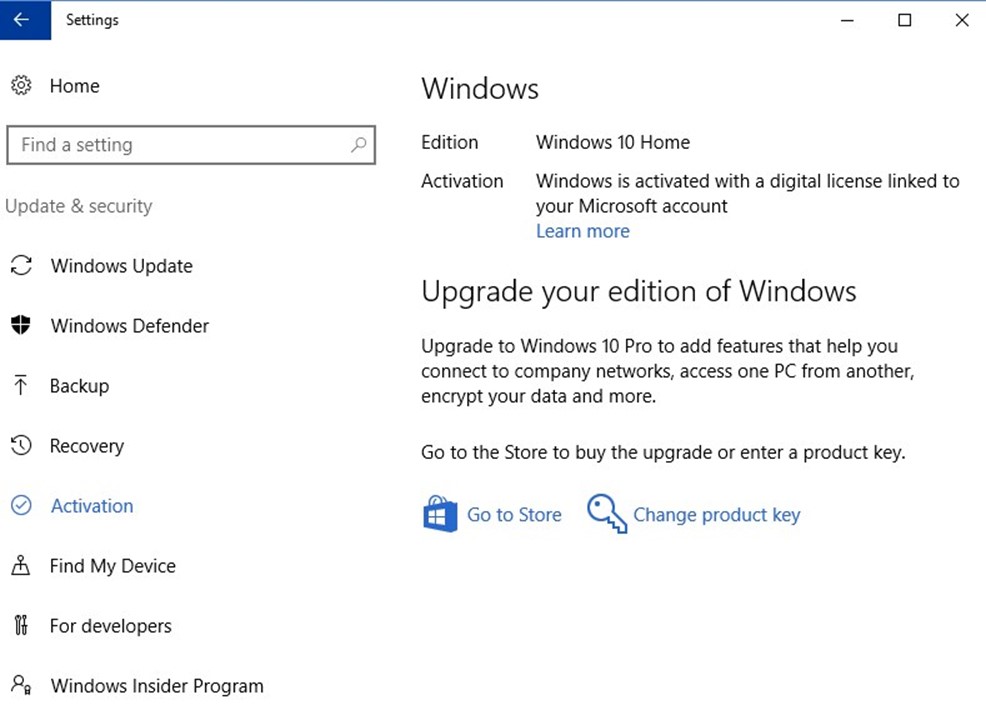
From the Windows Store, purchase the upgrade to Windows 10 Pro RS1.
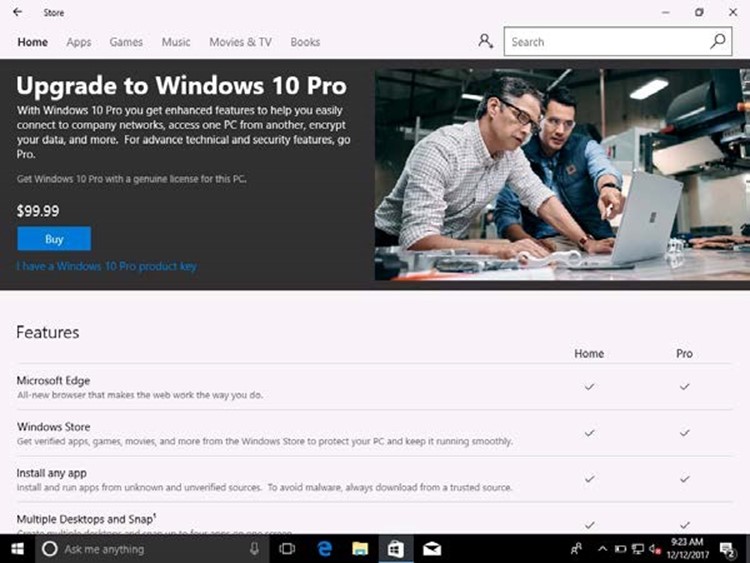
Upgrade considerations
Windows 10 was designed to run on a variety of machine types, but there are several aspects to consider before upgrading.
These are the minimum system requirements for Windows 10:
- Processor: 1 gigahertz (GHz) or faster processor or SoC
- RAM: 1 gigabyte (GB) for 32-bit operating system, or 2 GB for 64-bit
- Hard disk space: 16 GB for 32-bit operating system, 20 GB for 64-bit
- Graphics card: DirectX 9 or later with WDDM 1.0 driver
- Display: 800x600
For more information about Windows 10 system requirements, review Windows 10 specifications .
While the minimum system requirements for Windows 10 are modest, many features of Windows 10 are built for devices with hardware components and capabilities less common, or even absent, in devices from the Windows 7 era.
For example:
- Speech recognition will vary by device microphone. For a better speech experience, you will need:
- High fidelity microphone array.
- Hardware driver with microphone array geometry exposed.
- Windows Hello requires specialized illuminated infrared camera for facial recognition or a fingerprint reader that supports the Windows Biometric Framework.
- Continuum is available on all Windows 10 desktop editions by manually turning tablet mode on and off through the Action Center. Tablets and 2-in-1s with General-purpose input/output (GPIO) indicators, or those that have a laptop and slate indicator, can be configured to enter tablet mode automatically.
- Two-factor authentication requires the use of a PIN, biometric authentication (fingerprint reader or illuminated infrared camera), or a phone with Wi-Fi or Bluetooth capabilities.
- The number of applications that can be snapped will depend upon the minimum resolution for the application.
- To use touch, you need a tablet or a monitor that supports multi-touch.
- Secure boot requires firmware that supports UEFI v2.3.1 Errata B and has the Microsoft Windows Certification Authority in the UEFI signature database.
- Some games and programs might require a graphics card compatible with DirectX 10 or later for optimal performance.
- BitLocker requires either Trusted Platform Module (TPM) 1.2, TPM 2.0 or a USB flash drive (Windows 10 Pro and Windows 10 Enterprise only).
- Client Hyper-V requires a 64-bit system with second-level address translation (SLAT) capabilities and additional 2 GB of RAM (Windows 10 Pro and Windows 10 Enterprise only).
- Miracast requires a display adapter that supports Windows Display Driver Model (WDDM) 1.3, and a Wi-Fi adapter that supports Wi-Fi Direct.
- Wi-Fi Direct Printing requires a Wi-Fi adapter that supports Wi-Fi Direct and a device that supports Wi-Fi Direct Printing.
- To install a 64-bit operating system on a 64-bit PC, your processor must support CMPXCHG16b, PrefetchW, and LAHF/SAHF.
- InstantGo works only with computers designed for Connected Standby.
- Device encryption requires a PC with InstantGo and TPM 2.0.
For more information about the device capabilities of Windows 10, review the complete list of requirements.
To take full advantage of features and capabilities of Windows 10, a new Windows 10 Pro device is recommended.
Product keys and digital entitlements
The upgrade process does not issue or require 5x5 product keys.
As part of the upgrade process, customers receive a perpetual digital entitlement to Windows 10 that is associated with the device and stored in the Windows activation servers.
Once a device successfully upgrades to Windows 10 a digital entitlement is created in the Windows activation servers for that device, which means product keys are no longer required to reinstall and activate Windows 10.
For more information, see Activation in Windows 10 .
Blocked and complex upgrade scenarios
Some situations do not allow you to perform an in-place upgrade; in these cases, you can perform a traditional wipe-and-load deployment instead. Examples of these situations include:
- Changing from a 32-bit operating system to a 64-bit operating system.
- Changing from legacy BIOS (Basic Input/Output System) to UEFI (Unified Extensible Firmware Interface) booting.
- Windows To Go and Windows native VHD booting (also called 'boot from VHD').
- Devices that use third-party disk encryption software.
- Dual-boot and multiboot systems.
For more information about traditional deployment, see Windows 10 deployment scenarios.
Upgrade guidance
Upgrading to Windows 10 Pro from Windows 7/8/8.1 Pro
For companies running Windows 7 Pro, Windows 8 Pro, and Windows 8.1 Pro, the recommended path for deploying Windows 10 Pro uses the Windows installation program (Setup.exe) to perform an in-place upgrade. This automatically preserves all data, settings, applications, and drivers from the existing operating system and requires the least IT effort, because there is no need for a complex deployment infrastructure.
This description of the upgrade process assumes the organization has an active subscription to a CSP product that includes Windows upgrade benefits. For more information, see the document called Introduction to Windows 10 subscriptions in the Cloud Solution Provider program .
Before you start
Before you begin, check the following for each system to be upgraded:
- Systems to be upgraded must be running Windows 7 Pro, Window 8 Pro, or Windows 8.1 Pro.
- Systems must meet requirements.
- For each system to be upgraded, check for:
- 64-bit or 32-bit processor. Download either a 64-bit or 32-bit version of Windows 10.
- Language in Windows. Use or download matching media for the existing language of the device.
In-place upgrades
The in-place upgrade process is reliable and features the ability to automatically roll back to the previous operating system if any issues are encountered during deployment. You can also roll back manually by using the recovery information automatically created and stored in the Windows.old folder if you encounter issues within the first 10 days after completing the upgrade.
The in-place upgrade process is typically faster than traditional deployments because applications do not need to be reinstalled as part of the process. Admins can use the following procedure to access Windows 10 Pro upgrade options on the Microsoft Admin center. The Microsoft Admin center is the web-based portal organizations and partners use to manage user accounts and configuration settings for Microsoft 365 or Windows 10 subscription services.
Access Window 10 upgrade options in the Microsoft Admin center
On the Microsoft Admin center page, sign in to an Azure AD account with administrator privileges.
To open the Admin center, select the Admin tab.
Locate the Windows 10 Upgrade section, where you can choose from the following options:
- Install upgrade, which takes you to the Download Windows 10 page.
- Share the download link, which embeds the link in an email message.
- Create installation media, which takes you to the Download Windows 10 page.
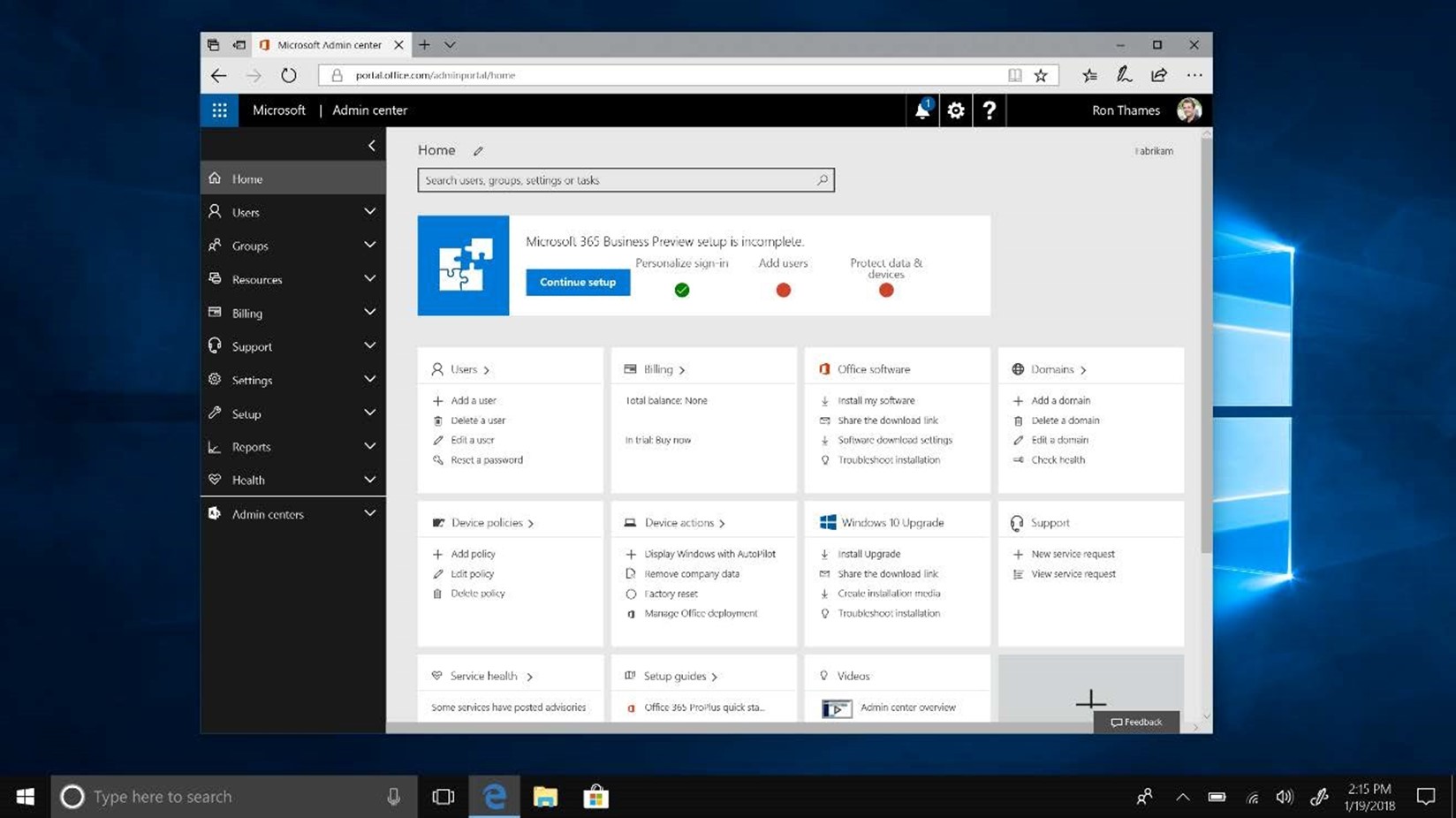
Use the following procedure when you have a license to install Windows 10 and are upgrading the device from Windows 7 Pro, Windows 8 Pro, or Windows 8.1 Pro. You must be an administrator on the device to run the upgrade tool.
Install the upgrade on the current machine
On the Download Windows 10 page, select Download tool now, and then click Run.

On the License terms page, read the license terms, and then select Accept.
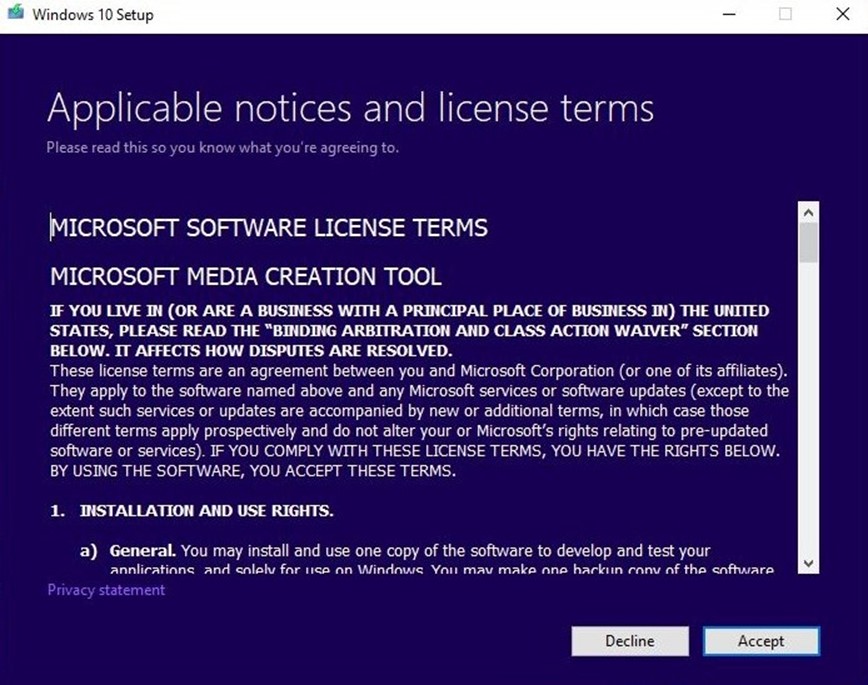
On the What do you want to do? page, click Upgrade this PC now, and then click Next.
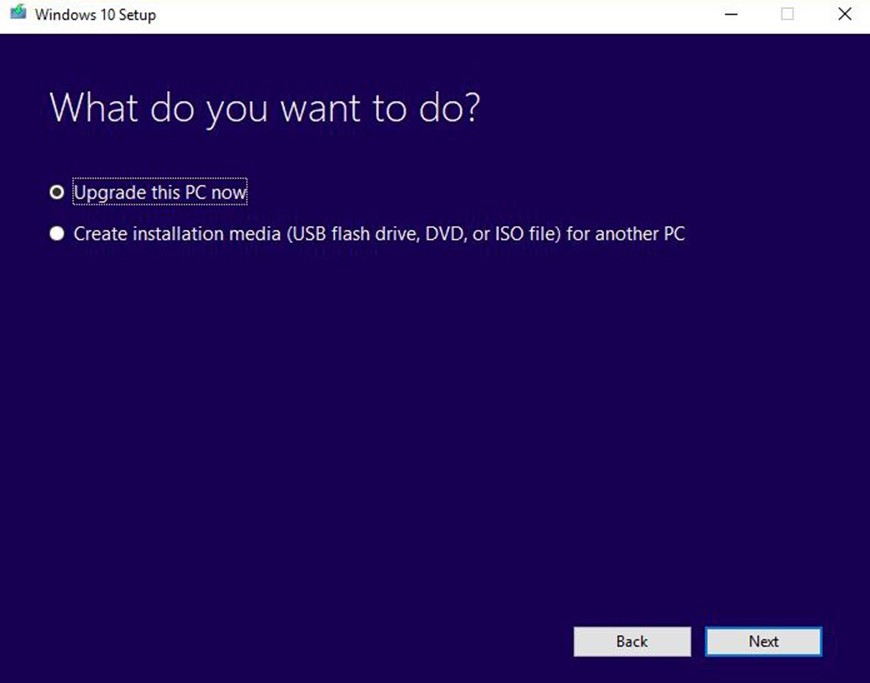
The tool starts downloading Windows 10 and walks you through how to set up Windows 10 on your PC. When Windows 10 is ready to install, a recap of what you've chosen appears, including what will be kept through the upgrade.
On the Choose what to keep page, specify which files and applications to retain during the upgrade.
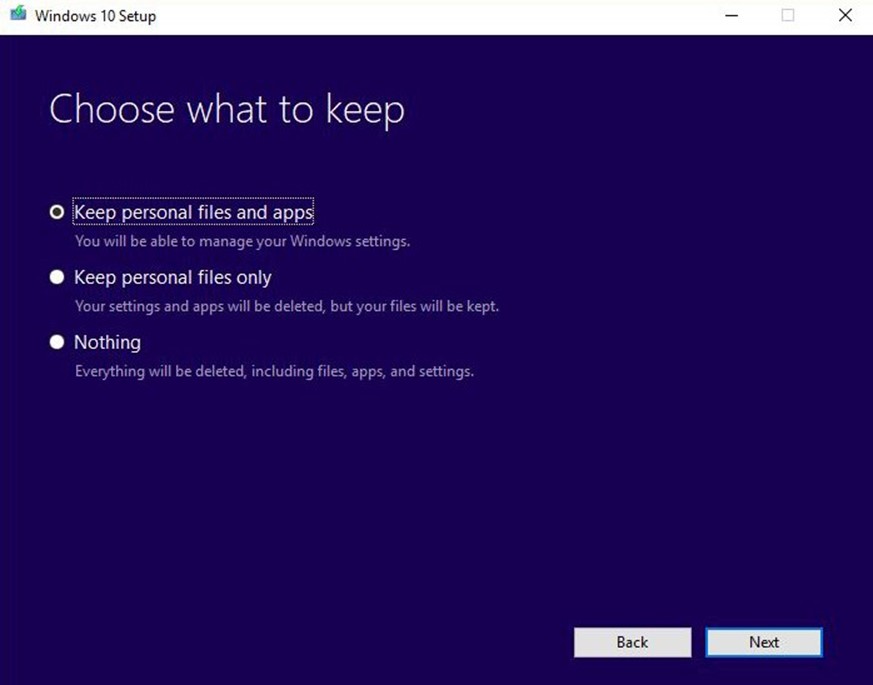
Save and close any open apps and files, and then click Install.
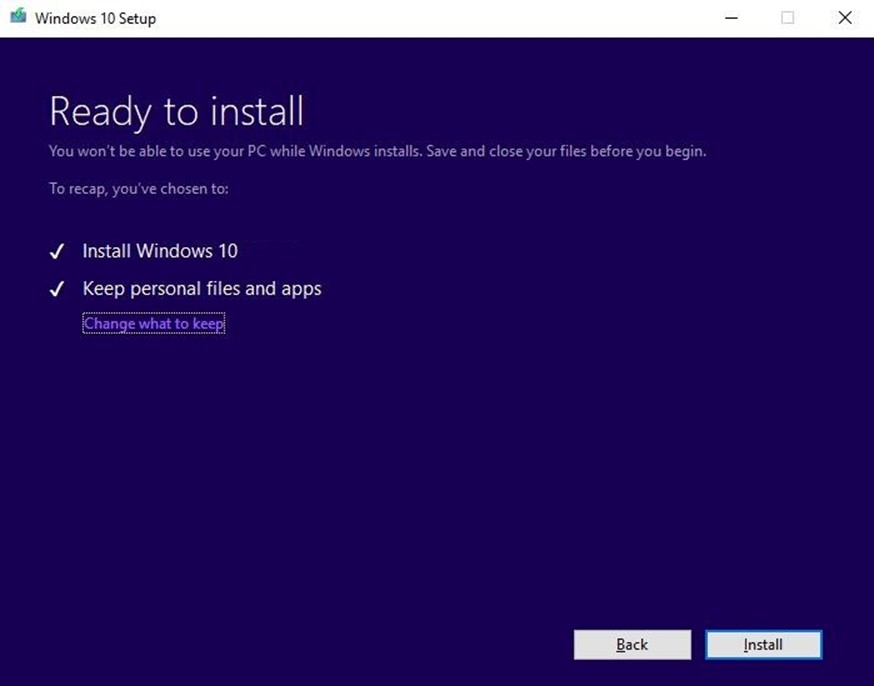
Installing Windows 10 may take some time and your PC will restart a few times. Do not turn off your PC during this process. After the process completes, the PC will be running Windows 10.
Create installation media
If you do not want to use the previous method for upgrading a PC to Windows 10, you can perform the upgrade using installation media.
Use the following procedure to create installation media you can use to install a new copy of Windows 10, perform a clean installation, or reinstall Windows 10.
Before downloading the media creation tool, make sure you have the following:
- An Internet connection
- Sufficient data storage available on a computer, USB, or external drive for the download. Microsoft recommends using a blank USB flash drive with at least 8 GB of space
To create installation media using the tool:
On the Download Windows 10 page, select Download tool now, and select Run.
You must be an administrator to run this tool.

On the License terms page, accept the license terms, and then select Accept.

On the What do you want to do? page, click Create installation media for another PC, and then select Next.
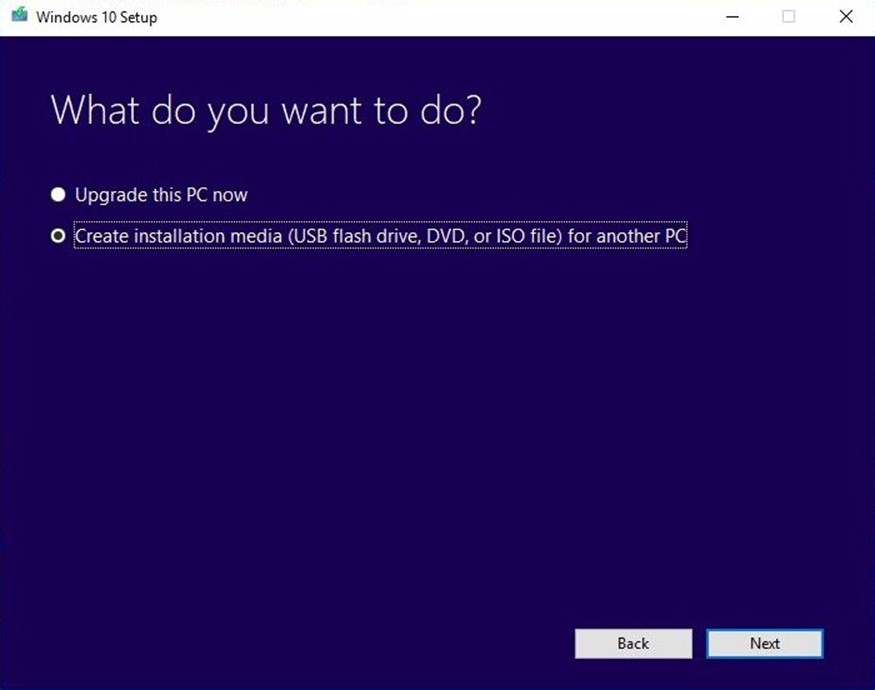
Select the language, edition, and architecture (64-bit or 32-bit) for Windows 10, and then select Next.
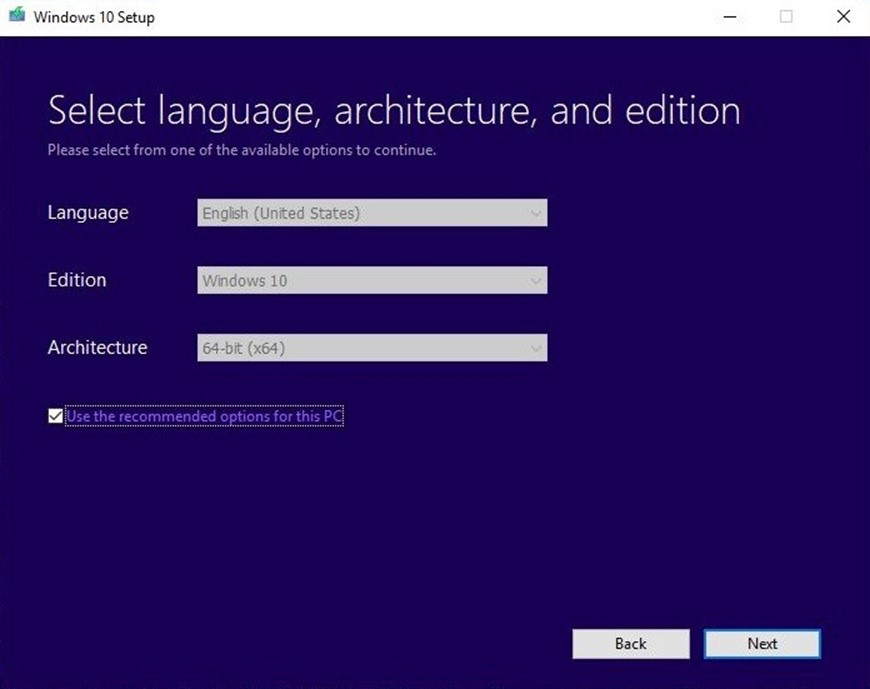
Select the media you want to use, and then select Next:
USB flash drive. Attach a blank USB flash drive with at least 8 GB of space.
ISO file. Save an ISO file to your PC that you can use to create a DVD. For information about using an ISO file, see Create Windows 10 installation media.
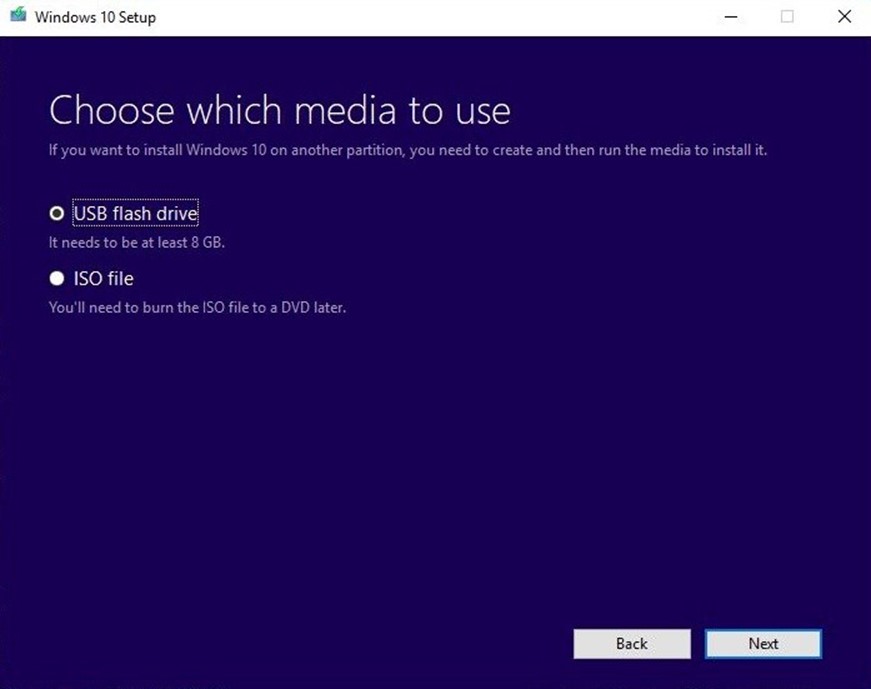
If you choose USB flash drive, you must specify the drive to use, and then select Next.
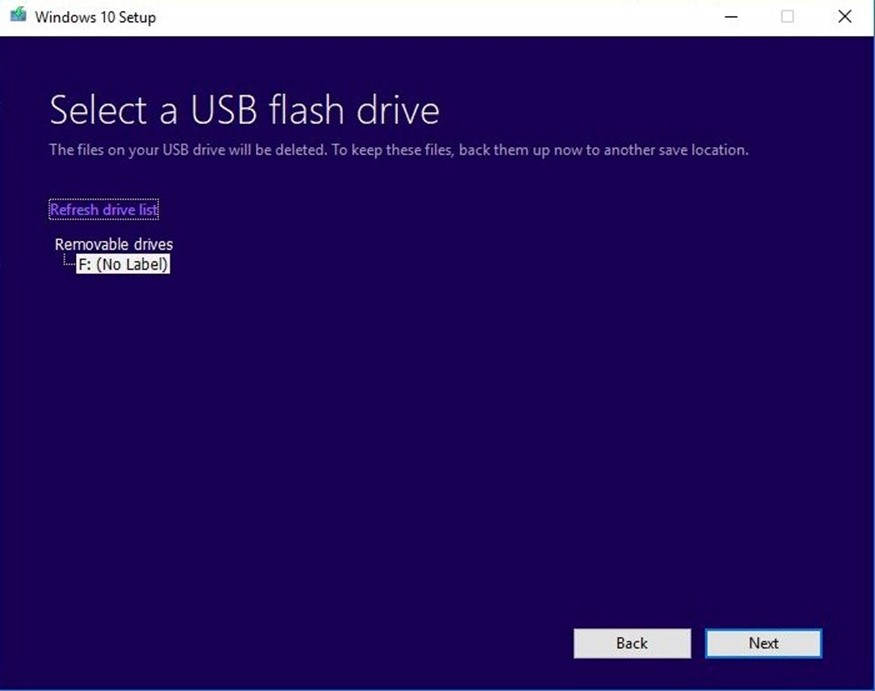
When the tool completes the installation media on the flash drive, it displays a message that the drive is ready. Click Finish.
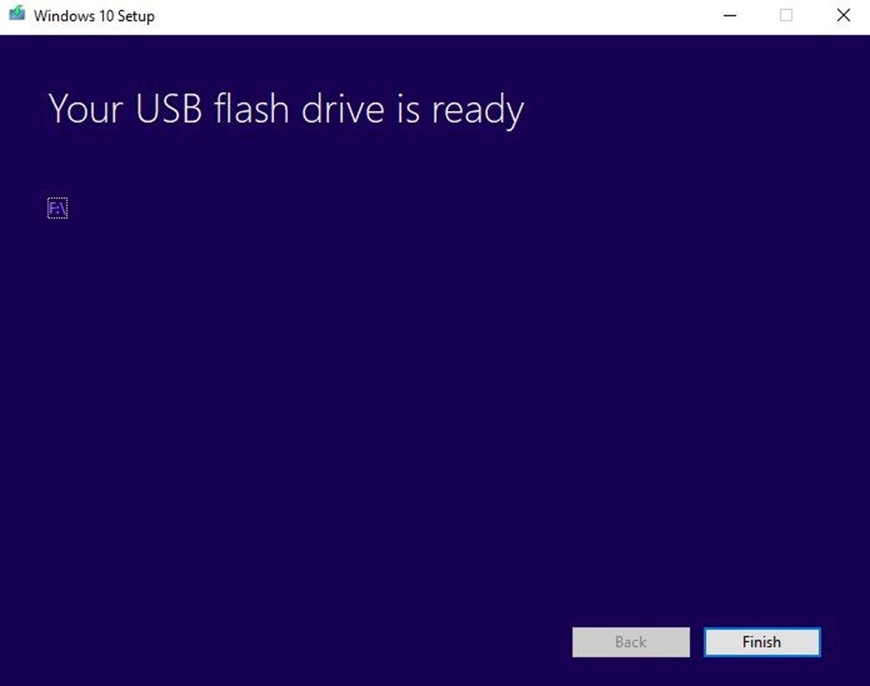
If you choose ISO file, you must specify a location for the image.
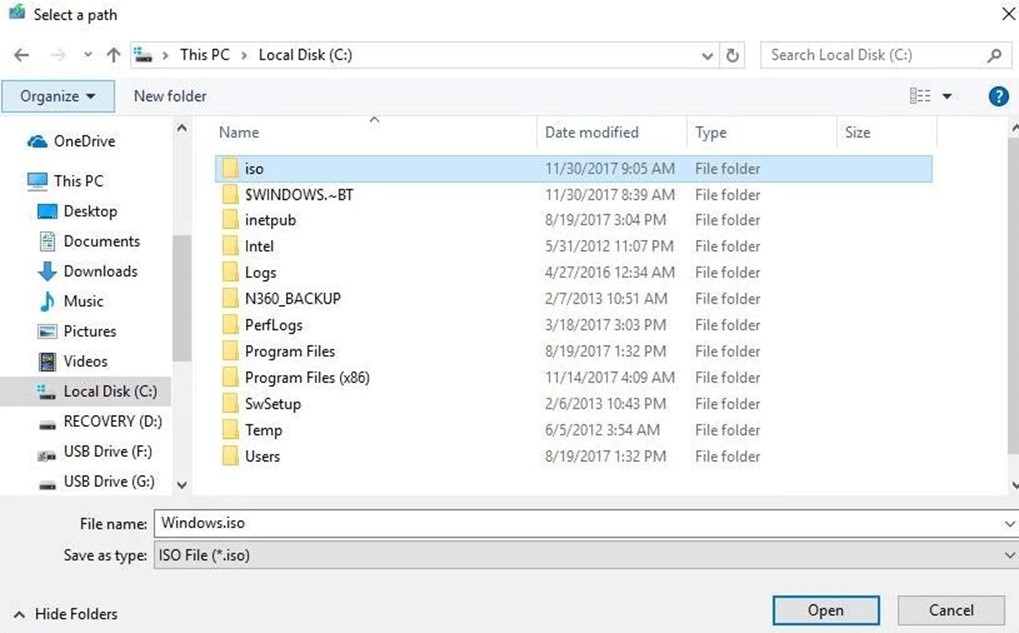
When the tool completes the image, it directs you to burn the file to a DVD. Click Finish.
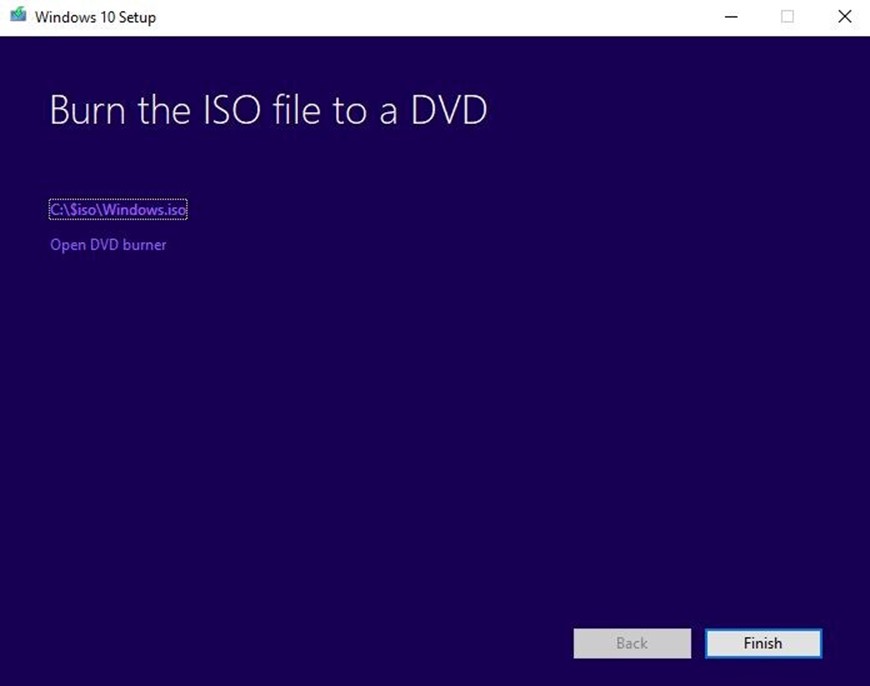
Install Windows 10 from the installation media
- Back up the computer where you plan to install Windows 10, and then shut down the computer.
- Attach the USB flash drive to the computer.
- Restart the computer to change the boot order to boot from the installation media.
- On the Install Windows page, select your language, time, and keyboard preferences, and then click Next.
- Click Install Windows.
When booting from USB/DVD, the previous activation state sometimes is not captured, and Windows 10 will prompt you for a key. You must enter the original OEM Pro license key for the device. Windows 7 Pro, Windows 8 Pro, and Windows 8.1 Pro OEM keys are all accepted. If you no longer have the packaging, you can attempt to extract the license key from the BIOS.
Troubleshooting the upgrade
If the upgrade encounters a problem, it will stop and report an error. There are many reasons you might receive an error message when upgrading, but common errors can be fixed with a few steps.
For more information about quick fixes for common errors, see Get help with Windows 10 upgrade and installation errors. For more detailed technical information, see Resolve Windows 10 upgrade errors.
Scale upgrades
Companies that want more control over the upgrade process or want to automate the upgrade process can perform scale upgrades. Scale upgrades require Microsoft and/or third-party IT tools and services to create an upgrade solution. See the Resources section in this document for more information.
Next steps
To get started, engage a service partner or work with Microsoft to develop a scaled solution.
- To find a Microsoft partner, see I'm looking for a solution provider
- To review support options for your business, see Support options for business users
Resources
- Deploy and update Windows 10
- Windows IT Pro Center
- Microsoft 365 Business Partner Resources
- Microsoft community
- Microsoft Deployment Toolkit
- Microsoft System Center 2012 R2 Configuration Manager
- Windows Server Update Services